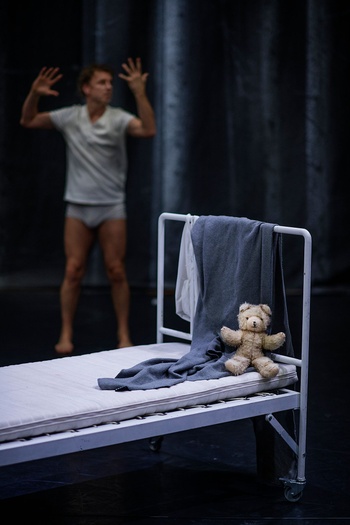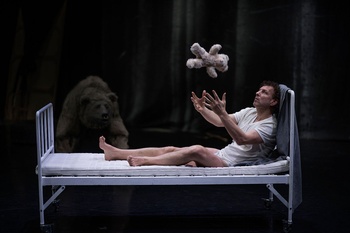Wim Vandekeybus has often collaborated with authors over the past few years. But for his newest piece, the choreographer has again followed his own head and instincts. All the way to the forests of Romania, Vandekeybus leads us along the tracks that led to Traces.
© Ivan Put
Also read: Le nouveau mythe de Wim Vandekeybus
About Wim Vandekeybus
- Was born in Herenthout in 1963
- Started psychology studies, but dropped out, and began following dance classes
- Founded his own company Ultima Vez in 1986, and debuted with the performance What the Body Does not Remember Loves working with people coming from different disciplines, but also likes to cast people without an artistic background
- Collaborates regularly with well-known musicians, such as David Byrne, Marc Ribot, Mauro Pawlowski and Trixie Whitley

© Ivan Put
“One of the central images in 'traces' is a forest road”
“Initially, I intended Traces to be a reflection on things I had made in the past, but that soon led to the idea of focusing on the traces we leave behind as people. Not only ecological traces, but all kinds of traces. In the meantime, Europalia Romania invited me to participate in the project and I spoke to many Romanian philosophers, artists, architects, etc. Due to the country's tumultuous history, this led me to political issues that I did not feel like engaging with at that time.”
“My friend, the photographer and filmmaker Pieter-Jan De Pue, who had cycled from Afghanistan to Belgium, told me about the Romanian forests, where there are still six thousand European bears. It is the last real wilderness in Europe, though even this area cannot be described as unspoiled. For example, eighty percent of the wood used by Ikea apparently comes from Romania. One of the central images in Traces, a first kind of trace, is a forest road. As soon as there is a road, a place becomes accessible and thus no longer untouched. At the same time, a lonely road in a forest is a good start to a horror film that plays with our fear of the wilderness. That is the atmosphere I was looking for.”
“Oops, the rabbit is dead”
“People cut the rabbit open in order to see what it looks like on the inside and to understand how it works. And then it suddenly becomes apparent that the rabbit is dead. Oops, the rabbit is dead. We live in a complex world, but it is important to have the courage to allow the unknown to exist. To allow the power of suggestion to do its work. In a very general way, this piece is as such a trace in the forest. It may be possible to find something at the end, but I certainly won't tell you what.”
“The stage setting is relatively simple and abstract. There is music and dance by ten dancers, some of whom are young, but there is no text. It is a ceremony of images that are very intense and that open the audience members' imaginations. It is not your role as a maker to depict things, but rather to create images that elicit an interpretation. You needn't describe reality, but show your own reality that contains a cluster bomb of possibilities. That is why I did not want colour but black and white. It is much more suggestive.”

© Ivan Put
“A teddy bear can be both soft and threatening”
“The bed on the stage is basically the only concrete theatrical element that we use. It is based on a photo from the end of the nineteenth century, of a young girl sitting on a similar bed with a real bear. The bed represents dreaming, the pain of someone who has to go to bed, the joy of jumping on a bed. And there is of course also the association with a teddy bear. We also include a teddy bear in the production, as a soft element that can nevertheless be used to make threatening scenes.”
“The teddy bear on the photo is mine. I had forgotten about it for years, and then my mother found it again. When she passed away last year, I took it with me and gave it to my son. He can't sit properly anymore like other teddy bears, but he is universal nonetheless. Until you are eighteen, you have your own room, your own bed, and a teddy bear marks out that personal territory that you create. But why is it a bear and not a dog, for example?”
“As a kid, I knew a Roma boy who lived in a car”
“We only see Roma in cities, but they also live in the countryside. My father was a vet in the Kempen (a region in the north-eastern part of Belgium and the south-eastern part of the Netherlands, mb) and we would sometimes visit the 'caravaners' as we called them; people who lived in caravans with their horses. While my father vaccinated the horses, I spent time with a boy who no longer slept in a caravan but had turned an old car into his home. I thought it was fantastic. I wanted to include something about the traces of those nomads.”
“Romania would prefer the Roma not to be called Roma to avoid any association, and Europe invests enormous sums to integrate these people into a society from which they would rather withdraw. We don't know what to do with people who have no fixed address or no official identity. And then the police come knocking. I knew somebody who had no job for a while but who was not unemployed. They had administrative problems for years. We are clearly part of a system in which there are no alternatives: it must be possible to identify and monitor everyone at all times.”

© Ivan Put
“The photographer Koudelka doesn't have email or a phone”
“Photos were also an important trace in creating the production. There had been a copy of the book Gypsies by the Czech-French photographer Josef Koudelka at my house for a long time. In the 1960s and 1970s, Koudelka took pictures of the Roma in Romania. For example, there is a photo of a woman standing proudly with her feet in the mud in front of a shack built of a few stones and a corrugated roof. We couldn't cover the stage in mud, but I absolutely wanted to do something with that pride. There is also a photo of a criminal being thrown out of the village. Or of a girl in a nightdress who is being watched by everyone. They are all beautiful photographs. Koudelka has a keen eye for things that are gradually disappearing, and he really infiltrated that community.”
“Koudelka is a member of the Magnum photo agency, but apparently, he doesn't have email or a telephone. I invited him via Carl De Keyzer, who is also a member of Magnum, but it turns out that he is ill and will not be able to attend the shows in December.”
“Roma music is the inspiration for the soundtrack”
“The Roma were also extremely important musically. For example, the pop-folk genre Manele is incredibly popular at the moment, though it is not really allowed to be played on the radio because some of the musicians use bad language and perform at mafia weddings. Trixie Whitley, Marc Ribot, Shahzad Ismaily, Ben Perowsky, and Daniel Mintseris are New York musicians, so we are not going to pretend to be gypsies. But the traces of the history of Roma music are the inspiration for the soundtrack. Marc Ribot's Spiritual Unity was inspired by a piece of the same name by Albert Ayler – an American who imitates all those Roma trumpets with his saxophone, while Ribot reproduces them on his guitar. Roma rarely play the same thing. They develop structures while playing, and that is how our musicians approached it too.”
“We leave so many traces of destruction in nature”
“I also spoke to several hunters in Romania, but they are very taciturn. It is not so long ago that hunters from Western Europe would travel to Romania at the end of the season so that they could continue to hunt, eat, and drink there. That is now forbidden, but in the past, it caused much irreparable damage. This leads you to damaging traces that people leave in nature. While I was occupied with the forests and trees in Romania, the fires in the Amazon were in the news and suddenly there were trees everywhere.”
“In contrast to the destruction that we cause ourselves, we have the bear as a metaphor of renewal. The first thing that really struck me in Romania and that became a kind of anchor was a New Year's ritual during which people put on a complete bearskin and then process through the village while drinking and smoking. This happens in the period during which the bears are hibernating and feeding their young while asleep, so that they can reawaken in the spring.”
“There is something incredibly human about a bear”
“Why a teddy bear and not a teddy dog? There is something incredibly human about a bear. Quiet and cuddly, but also explosive and murderous. In Romania, you often still hear stories of people who want to take photos inside bear dens and just get killed. In the past, bears were sometimes given vodka and made to dance on hot sheets of metal. When the EU banned that practice and the sick animals were moved into sanatoriums, those people not only lost their jobs but also their 'children', and they wrote letters to the EU to complain about the new legislation. To say that the animals would weep as they did. People like anthropomorphizing animals. Baloo is a person in a bigger body.”
“We don't use real bearskins in the production, but we studied bear physiognomy with Jan Maillard from theatre company FroeFroe, and despite the fact that bears, in comparison to humans, have longer arms than legs, we try to imitate their movements.”
Read more about: Podium
Fijn dat je wil reageren. Wie reageert, gaat akkoord met onze huisregels. Hoe reageren via Disqus? Een woordje uitleg.